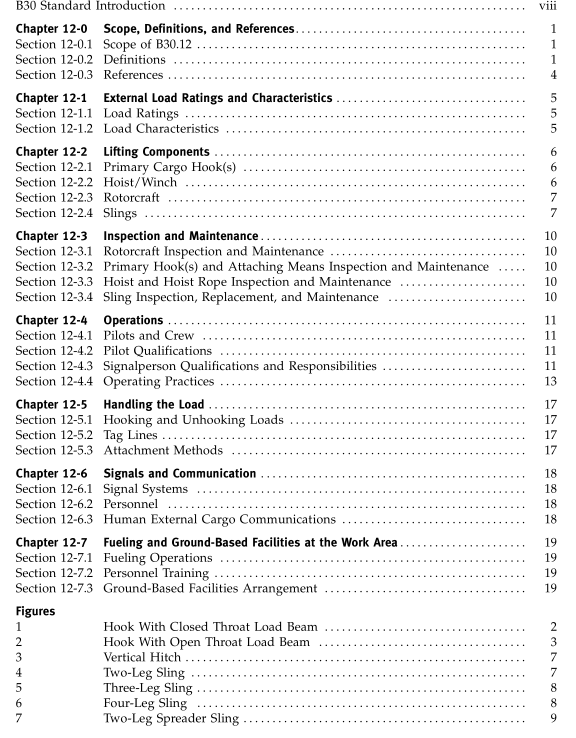ASME B30.12 pdf download

ASME B30.12 pdf download Handling Loads Suspended From Rotorcraft Safety Standard for Cableways, Cranes, Derricks, Hoists, Hooks, Jacks, and Slings
jettisonable load: a Class B,C, or D rotorcraft externalload that can be intentionally released by the pilot ordesignated flight crew member, in flight, using either aprimary or backup quick release system.
keeper: a device, usually spring loaded , that prevents theapex fitting of a sling from slipping off the load beamof the cargo hook (see Fig. 2).
kV: kilovolts. Equal to 1000 v of electricity.
large aircraft: an aircraft of more than 12,500 lb, maximumcertificated takeoff weight.
lift: to raise the load by flight of the rotorcraft.
linit loads: the maximum load(s) to be expected inservice.
limit switch: a device that, by predetermined adjustment,limits the rotational or linear movement of a mechanism.load: the static weight of the object being lifted or low-ered, including the sling and any other ancillary attach-ments, not included as part of the rotorcraft or rotorcrafthoist system.
load ratings: the maximum load that a rotorcraft or otheritem of lifting equipment is authorized to lift, as speci-fied by the manufacturer, the FAA, or applicable regula-tory authority.
main rotor(s): the rotor that supplies the principal lift toa rotorcraft.
manual release device: a cargo hook-mounted, mechanicalrelease mechanism typically used by ground crews toopen the cargo hook independent from the rotorcraft’sprimary or backup quick release system (see Fig. 2).axinunm gross zoeight: the maximum approved grossweight of the rotorcraft and its load in any configuration.
nonrhuman external cargo (NHEC): any external cargooperation that does not, at any time, involve a person(s)carried external to the rotorcraft.
open throaf load beam: that load-bearing member of acargo hook designed so that in its normal operatingposition, it is possible to slide the apex fitting of a slingdirectly onto the load beam without opening the hook(see Fig. 2).
operafion: this pertains to the utilization of a rotorcraftlifting loads outside its fuselage in order to accomplishvarious lifting and placing tasks.The task may consistof just one lift or may be of long or indefinite duration.See also external lift or load operationr.
operator: the company, firm individual, or other businessenterprise owning or leasing the rotorcraft that is respon-sible for its functioning and airworthiness.
penidant: a synthetic or wire rope, chain, or webbing ofspecific length with fixed end connections.
personne1-carrying device system (PCDS): the entireattached or suspended system used to carry humanexternal cargo.This is any human external cargo-carrying configuration, such as a suspended (e.g.,winch/ hoist, cable,harness) human external cargo sys-tem or an attached (e-g-, a rigid basket or cage attachedto the skids) human external cargo system.
pilof-in-comand (PIC): the person who has the finalauthority and responsibility for the operation and safetyof the flight, has been designated as pilot in commandbefore or during the flight, and holds the appropriatecategory,class,and type rating. if appropriate, for theconduct of the flight.
primary quick-release subsysfem (PQRS): the primary orfirst choice” subsystem used to perform a normal oremergency jettison of external cargo.
uualiffed person: a person who, by possession of a recog-nized degree in an applicable field or certificate of pro-fessional standing or who by extensive knowledge,training,and experience, has successfully demonstratedthe ability to solve or resolve problems relating to thesubject matter and work.
quick-release systenm (QRS): the entire release system forjettisonable external cargo (i.e.,the sum total of boththe primary and backup quick-release subsystems).TheQRs consists of all components, including the controls,the release devices, and everything in between.
rated load: the maximum allowable working load estab-lished by the lifting component manufacturer.
rating: a statement that,as a part of a certificate, setsforth special conditions, privileges, or limitations.
rescue hook: a hook that can be rated for both HEC andNHEC. It is ty pically used in conjunction with a winch/hoist or equivalent system.
rope: refers to wire rope unless otherwise specified.









